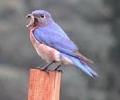TOMBSTONE BLUEBIRDS
by Leif Marking
Bluebirds desire open spaces that are grazed or mowed for searching and foraging insects for themselves and their young. Cemeteries often offer this ideal habitat, especially if there are not a lot of forest-type trees that form a canopy. I selected Neshonoc cemetery in La Crosse Co. near West Salem, WI to challenge bluebirds to use my nest boxes. Opposite east-west boundaries were chosen to gain about 200 yards distance because bluebirds are territorial, and they are not comfortable when other cavity nesters are near.
I placed the west box in late June of 2002 after seeing a pair in the cemetery, and one week later the bluebirds had built a nest and already laid two eggs. As I drove out the east exit I spotted another pair, so I returned immediately with another house and predator protected steel post for the east boundary fence line to avoid conflict with mowing. Amazingly, a pair of bluebirds watched from tombstone perches as I installed the house. One of the tombstones was that of my great-grandparents, Johannes and Gelena Nelson, who emigrated from Norway with their family. Needless to say, those bluebirds quickly adopted that house and reared five youngsters to fledging.
Both pair of tombstone bluebirds returned early in spring 2003 and set up house keeping in the cemetery houses. I assumed they were the same birds from last year because they were familiar with my presence and existing perches. By the end of May both pair was feeding their five feathering youngsters. These ten healthy youngsters fledged in mid June, much to my delight. Then I anticipated good second nesting counts to boost my production rate and overall total.
The pair in the west house resumed nesting activity within ten days and laid four eggs. The pair in the east house waited three weeks and then produced five eggs. All the eggs hatched, and the healthy youngsters in the west were ready to fledge during my weekly check. However, only one frightened youngster, partially covered with threshed nesting material, remained in the east house, and the frantic mother protectively flew about in despair. I was totally frustrated, so I responsibly returned the next day to find the fifth one gone.
Upon examination, I identified fine claw scratches on both sides of the house. Apparently a cat had jumped six feet from the ground to the house and extracted all the young bluebirds for consumption. Then I checked the west house to find it empty with several claw marks. Can you imagine those youngsters fledging and escaping the cat?


 gmail.com
gmail.com